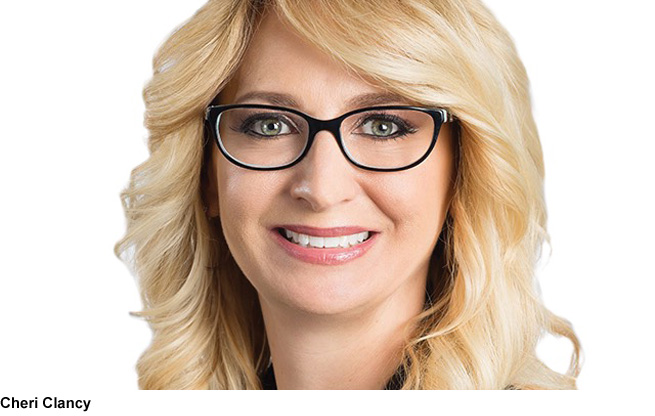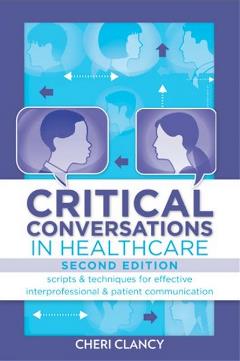Maybe you need road maps for effective interprofessional and patient communication!

Cheri Clancy, author of Critical Conversations in Healthcare, Second Edition, responds to questions from James Mattson, editor of Reflections on Nursing Leadership (RNL).
RNL:
Your book contains a wealth of information about how to achieve effective communication with co-workers, supervisors, patients, and others. You provide both the “why”—why certain approaches work or don’t work—as well as the “how,” including adaptable scripts that help readers navigate necessary but dreaded conversations. You are a nurse with master’s degrees in health administration and organizational leadership. Tell me about your journey from newly minted nurse with a BSN degree to nurse entrepreneur helping other nurses handle difficult communication challenges.
Cheri Clancy:
 I consider my path nontraditional, although I’ve held increasingly responsible leadership positions. I began my clinical career in the neonatal intensive care nursery. Although I enjoyed caring for sick and vulnerable babies, I was always intrigued by how leadership decisions were made. For example, I was interested in how staffing ratios were set, why certain equipment was selected, and why informal and formal education was so vital in the nursing profession.
I consider my path nontraditional, although I’ve held increasingly responsible leadership positions. I began my clinical career in the neonatal intensive care nursery. Although I enjoyed caring for sick and vulnerable babies, I was always intrigued by how leadership decisions were made. For example, I was interested in how staffing ratios were set, why certain equipment was selected, and why informal and formal education was so vital in the nursing profession.
To learn more about leadership, I accepted my first formal leadership position in an ambulatory care environment. In the years that followed, I was selected as a director of nursing, an adjunct faculty member teaching nursing leadership courses, and an assistant vice president of patient experience. As the founder of Cheri Clancy and Associates LLC, I speak and consult on various leadership topics, such as critical conversations, emotional intelligence, empathy, and patient experience strategy. Although my career path has taken me in a variety of directions, leadership skills are transferable and are the foundation to success—regardless of title. My journey gives me perspective for the entire care continuum as well as how education, quality, and research support organizational priorities.
RNL:
You put readers of your book “in the driver’s seat” as you teach them how to navigate difficult communication challenges for the purpose of improving relationships and delivering optimal healthcare. You provide “road maps” to help them find the way and, at the end of each chapter, recap lessons learned on “the drive home.” Automobile drivers sometimes lose their way or encounter unforeseen roadblocks and have to find other paths to their desired destinations. Does your book help lost or roadblocked conversation drivers recalculate and get back on a communication path that leads to success? Can you provide an example or two, from the book or perhaps personal experience or observation, that gives wayward drivers hope that all is not lost when things don’t go as planned?
Clancy:
Yes, my book can help lost or roadblocked drivers recalculate their communication paths. I am a huge advocate of using easy-to-recall acronyms that provide a framework for staying the course. For example, I’ve witnessed some very awkward conversations about performance management issues between those with formal leadership titles and the people who report to them. Specifically, I’ve observed a leader attempt to be nice by starting a serious conversation with small talk—discussing a sports team win (or loss) or giving compliments about style, such as the other person’s earrings—anything to “break the ice.” The leader doesn’t know how to get to the point, and the direct report feels blindsided when what seems like a benign and friendly conversation turns into a serious discussion about a performance management issue. In addition to making emotions run high, this approach causes the employee to become defensive and lose trust in his or her leader.
Using the TELL acronym helps leaders hold critical conversations without straying from what’s most important. The T reminds them to tell the person what the issue is—lateness, for example. The E prompts them to explain why tardiness is an issue—it relates directly to patient care. The first L reminds the conversation initiator to listen and lead the other person to what the expectation is (not just stating what not to do). The second L stands for learn the consequence. This simply means to inform the person what the next step will be if the behavior happens again. Using TELL as a guideline helps wayward drivers stay on track. If they do get lost, they have a tool that reminds them how to get back on course.
RNL:
Some people just have a way with words. Confronted by seemingly insurmountable communication challenges, they get their point across and defuse negative situations without getting angry or making the offender and everybody else upset. They’re born diplomats, it seems. They say middle children are born negotiators. What if you’re the youngest in your family—like me—or the oldest? Can your book help us? Explain.
Clancy:
I agree. Some people are very articulate and naturally fluent in putting thoughts into meaningful words. Although I am a middle child, I’ve struggled with finding the right words at the right time. Hence, I decided to write a book about conducting effective conversations. My leadership background, including how to improve patient and family experiences, has taught me that it’s often not the words we choose but our nonverbal behaviors that speak the loudest—that our words may have no value because our actions are so much more impactful. Simply being present and sitting with someone in silence can be very powerful.
In my book, I demystify body language—conscious and unconscious gesturing, for example—and help readers understand the importance of congruence. Do the position of our body and the gestures we make match the words we say? If you’ve ever had a conversation with a teenager who augments one-word answers with a huff, a sigh, or eye-rolling, you know the importance of congruence. My book goes beyond the obvious and helps readers identify what they consciously and unconsciously translate. Instead of reacting to their emotions, they learn how to manage them when they sense incongruence and other disconnects.
RNL:
For nurses and others in healthcare, identify one or two features of your book that make it a great go-to resource for those wanting to become better leaders and interpersonal communicators.
Clancy:
My book includes a lot of how-to guidance on putting leadership principles into practice; it doesn’t focus just on theory. For example, I discuss the importance of emotional intelligence as well as how to improve your emotional intelligence. I share the importance of being mindful in communication as well as how to practice mindfulness. Other topics include how to hold peer-to-peer conversations (as opposed to leader-initiated performance management exchanges). Patient-experience best practices are discussed as well as how organizational culture and teamwork intersect the “why and how” of what we do.
I address concepts in the book that often go undiscussed—but make organizational and leadership success so fascinating. To make a positive difference in the lives of our patients, families, and ourselves, we need to understand and assess our own thoughts, actions, and behaviors. We are humans serving humans, so it is of cardinal importance that we not only understand concepts and theories but also put what we know into practice.
RNL:
This is the second edition of Critical Conversations in Healthcare. How does the new edition differ from the earlier version?
Clancy:
All of the chapters in the first edition have been edited to update and freshen content. Two chapters have been added that address the concepts of mindfulness and neuroleadership as they relate to effective communication strategies. Just as scripts in the first edition serve as practical, tactic-driven templates for effective conversations, the mind over body—and vice versa—information contained in the second edition enables readers to take a deep dive into the science of why we do what we do and how this knowledge becomes either an ally or an enemy in our conversations. These chapters explain our thought processes from a physiological standpoint and provide tactics for rewiring our minds. RNL
Cheri Clancy, MSN, MS, RN, NEA-BC, CPXP, author of Critical Conversations in Healthcare, Second Edition, is the founder of Cheri Clancy & Associates LLC, a patient-experience coaching firm that uses hard science as a catalyst for soft-skill leadership development. Featured as “The Leader to Watch” in Voice of Nursing Leadership, an online member magazine published by the American Organization of Nurse Executives, Clancy was the 2018 recipient of the Beacon of Light Award presented by the Institute for Nursing, the foundation affiliate of New Jersey State Nurses Association.